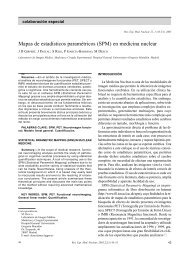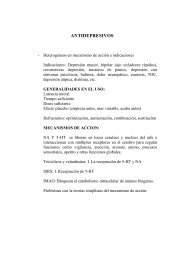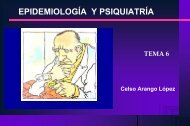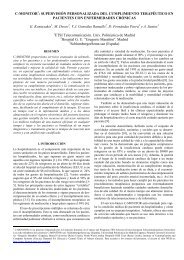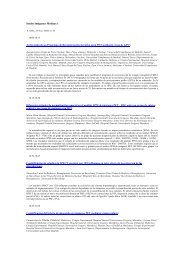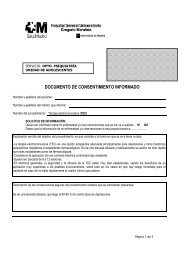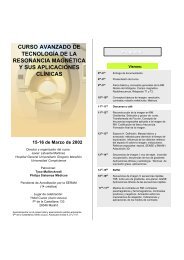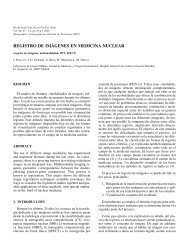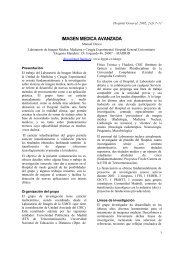Method for Bias Field Correction of Brain T1-Weighted Magnetic ...
Method for Bias Field Correction of Brain T1-Weighted Magnetic ...
Method for Bias Field Correction of Brain T1-Weighted Magnetic ...
Create successful ePaper yourself
Turn your PDF publications into a flip-book with our unique Google optimized e-Paper software.
<strong>Bias</strong> <strong>Field</strong> <strong>Correction</strong> <strong>of</strong> <strong>T1</strong>-<strong>Weighted</strong> MR Images <br />
intensity both in the bias-free image and in the original<br />
one. Both images are then filtered with the same gaussian<br />
kernel. When the CER is no longer improved using a<br />
particular kernel size, its full width at half maximum<br />
(FWHM) is reduced to a half. With our images, the kernel<br />
size varied from 200 mm in the first iteration to 50 mm in<br />
the last one.<br />
At this point, the bias field is estimated as the quotient<br />
between the smoothed versions <strong>of</strong> the original and bias-free<br />
images (Fig. 3c). This procedure, however, does not provide<br />
a good estimation <strong>of</strong> the magnitude <strong>of</strong> the bias field, but the<br />
estimation can be optimized further to minimize the classification<br />
error. To this end, the original image is corrected<br />
with bias fields <strong>of</strong> different magnitudes, from 0–40% in<br />
steps <strong>of</strong> 1%, selecting the value that yields the lowest classification<br />
error.<br />
A bias-corrected MR image is calculated as the quotient<br />
between the original image and the estimated bias field. This<br />
corrected MR image is then entered as the original image in<br />
the tissue classification step, iterating the whole procedure<br />
until no improvement in the classification error is obtained<br />
in three consecutive steps. The parameter minimized by the<br />
NIC algorithm is actually the CER, despite the use <strong>of</strong> a<br />
maximum-likelihood EM algorithm in the tissue classification<br />
stage.<br />
Validation<br />
With the aim <strong>of</strong> thoroughly testing the per<strong>for</strong>mance <strong>of</strong> the<br />
NIC algorithm, both phantom and real image datasets were<br />
used. The main advantage <strong>of</strong> using realistic phantom images is<br />
that it enables assessment <strong>of</strong> the accuracy <strong>of</strong> the algorithm. The<br />
procedure works by adding a known multiplicative bias field<br />
and measuring the difference between the applied and extracted<br />
bias fields. These phantom images, on the other hand,<br />
may not be representative <strong>of</strong> real clinical cases. To assess the<br />
per<strong>for</strong>mance <strong>of</strong> the algorithm with real cases, we followed a<br />
different strategy. Because in this case the actual bias field was<br />
unknown, the evaluation was carried out by comparing parameters<br />
that estimate the residual amount <strong>of</strong> variability <strong>of</strong><br />
every tissue in the image after correcting the bias field.<br />
Phantom Dataset<br />
To facilitate comparison <strong>of</strong> our results to previous ones,<br />
we evaluated the NIC algorithm following the methodology<br />
proposed by Arnold et al. [2001], who studied six inhomogeneity<br />
correction methods 1 : N3 [Sled et al., 1998]; HUM<br />
[Brinkmann et al., 1998]; EQ [Cohen et al., 2000]; BFC [Shattuck<br />
et al., 2001]; SPM [Ashburner and Friston, 2000]; and<br />
CMA. 2 A paraboloidal and a sinusoidal bias field <strong>of</strong> maximum<br />
magnitude 8% bias fields were added to a realistic<br />
1 N3, nonparametric, nonuni<strong>for</strong>m intensity normalization; HUM,<br />
homomorphic unsharp masking; EQ, equalize; BFC, bias field corrector;<br />
SPM, statistical parametric mapping.<br />
2 Developed and provided by the Center <strong>for</strong> Morphometric Analysis<br />
at the Massachusetts General Hospital.<br />
MR brain phantom [Collins et al., 1998] with 3% gaussian<br />
noise. These phantom images are freely available in the<br />
Internet. 3 The quality <strong>of</strong> the correction was assessed by a<br />
scatterplot <strong>of</strong> applied versus extracted bias fields and its<br />
correlation coefficient (r). Ideally, the applied and extracted<br />
bias should have exactly the same shape and magnitude,<br />
with the scatterplot showing a perfectly straight slope <strong>of</strong> b<br />
1 with a correlation coefficient <strong>of</strong> r 1. The algorithm was<br />
also applied to the original phantom image without bias<br />
field to verify that no degradation was introduced in this<br />
case.<br />
Real Image Dataset<br />
Our real image dataset consisted <strong>of</strong> 24 brain MR images <strong>of</strong><br />
four healthy volunteers. Images were acquired in two clinical<br />
scanners (Gyroscan; Philips, The Netherlands) using a<br />
head coil, with 12 images at 0.5 T and 12 at 1.5 T. Each<br />
subject was scanned three times in every MR system. MR<br />
images were acquired using a <strong>T1</strong>-weighted 3D gradient echo<br />
sequence (flip angle 30 degrees, repetition time 15.4<br />
msec, echo time 4.6 msec), with a matrix size <strong>of</strong> 256 256<br />
110, and voxel size <strong>of</strong> 0.98 0.98 1.10 mm. The MRI<br />
acquisition protocol was intended to produce bias fields <strong>of</strong><br />
different strength and shape. Images at the higher B 0 field<br />
(1.5 T, 64 MHz) were expected to present a stronger bias<br />
field than were those obtained at a lower field (0.5 T, 22<br />
MHz), because the intensity inhomogeneity depended on RF<br />
signal attenuation inside the object under study [Sled and<br />
Pike, 1998]. To modify the shape <strong>of</strong> the bias field, the scanner<br />
bed was moved 1.5 cm in the second and third repetitions,<br />
presuming that a change in the relative positions <strong>of</strong> the<br />
emitting and receiving coils should produce a different map<br />
<strong>of</strong> sensitivity, thus varying the shape <strong>of</strong> the bias field [Deichmann<br />
et al., 2002].<br />
We used four parameters to assess the quality <strong>of</strong> intensity<br />
inhomogeneity correction: the coefficients <strong>of</strong> variation <strong>of</strong><br />
gray and white matter; the coefficient <strong>of</strong> joint variation <strong>of</strong><br />
gray and white matter; and the CER (the parameter minimized<br />
by our algorithm). The coefficient <strong>of</strong> variation <strong>of</strong> the<br />
white matter (CV WM ) and gray matter (CV GM ) have been<br />
employed widely as goodness parameters [Chard et al.,<br />
2002; Dawant et al., 1993; Likar et al., 2001; Sled et al., 1998].<br />
Coefficients <strong>of</strong> variation constitute a scale-independent measurement<br />
<strong>of</strong> the voxel intensity variability <strong>for</strong> any particular<br />
tissue type. Their interpretation may be difficult, however,<br />
when one tissue shows improvement and other shows degradation.<br />
Another parameter, the coefficient <strong>of</strong> joint variation<br />
<strong>of</strong> white and gray matter (CJV WG ), was proposed to<br />
overcome this problem [Likar et al., 2001]. It is defined by<br />
WM GM<br />
CJV WG <br />
WM GM<br />
3 Available online at http://pet.med.va.gov:8080/distrib/nu_compare.html<br />
(3)<br />
137



